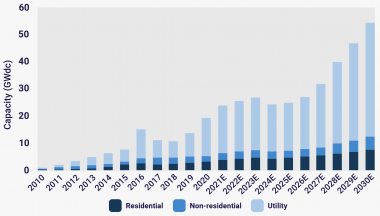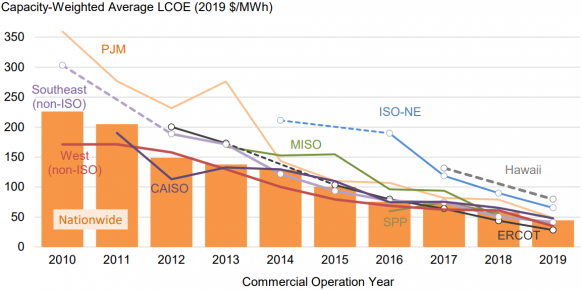US solar builders hike labour productivity ahead of growth jump
Solar builders are using economies of scale and improved component handling and scheduling to drive up labour productivity in the dominant utility-scale market.

Related Articles
The latest US Solar Jobs Census showed how increasing productivity is curbing labour requirements and costs for utility-scale solar construction. US solar activity is set to accelerate sharply in the coming years as support measures introduced by the Biden administration take hold. President Biden aims to decarbonise the power sector by 2035 and extend the investment tax credit (ITC) for solar projects by 10 years.
US solar installation forecast
(Click image to enlarge)
Source: Solar Energy Industry Association (SEIA), Wood Mackenzie, March 2021
US solar installations hiked by 43% last year to a record 19.2 GW but solar employment fell by 6.7% as coronavirus restrictions curbed activity and labour productivity rose in the fast-growing utility-scale segment, industry group Solar Foundation said in its latest annual jobs census. The US solar sector employed 231,474 workers at the end of 2020, compared with a forecast 302,000 jobs before the pandemic, the Solar Energy Industry Association (SEIA), co-author of the census, said.
Labour productivity in the utility-scale segment soared by 32% last year while productivity in the residential market rose 19%, based on installed capacity per hour of labour, the census said.
Utility-scale developers are building larger projects and using technology gains and improved construction practices to maximise economies of scale. Regions with strong solar activity, such as Texas, or established solar communities, offer greater access to industry expertise and equipment. Larger developers and construction groups are able to rotate teams and standardise equipment and installation processes.
Developer Pine Gate Renewables recently created a separate EPC business, Blue Ridge Power, and will expand the group through mergers and acquisitions (M&A) and hiring new staff, Chris Dunbar, CEO of Blue Ridge Power, told Reuters Events.
"We would like to get more vertically-integrated in the installation life cycle...Taking on scopes such as [medium voltage, high voltage], substation work and battery integration," Dunbar said.
"The more control we have over the workforce and the different trades, the more efficient we can be with project execution,” he said.
Design gains
Growing labour productivity will impact President Joe Biden's pledge to create millions of renewable energy jobs in the coming years. US solar growth is currently being driven by utility-scale development, which is far less labour-intensive to install per watt than residential and small business projects.
Utility-scale PV developers are installing larger, higher efficiency PV modules and bifacial systems, reducing labour requirements and average costs.
Additional improvements include reducing material requirements and assembling components in a factory setting where variables are easier to control, Kevin Sheehan, Senior Director of Supply Chain at renewable energy developer BayWa r.e. Solar Projects, said.
Construction groups are also integrating manufacturing expertise into their teams.
"By applying lean manufacturing strategies that improve the ergonomics and quality of the large solar projects we are improving productivity," Scott Canada, Executive Vice President of Renewable Energy & Storage at McCarthy Building Companies, said.
These strategies include the use of zero gravity tools for assembly, information loops on pile quality, and modular installation, he said.
Levelised cost of US utility-scale PV by market
(Click image to enlarge)
Source: Berkeley Lab, November 2020
Developers have also improved the layout of solar farms to aid installation and operations and maintenance (O&M).
Going forward, more detailed craft training programs in areas such as wire management will help improve plant reliability and reduce outages, Canada said.
“Repeatability is another improvement area," Sheehan said. "Small improvements to tasks that are performed thousands of times creates meaningful impacts.”
Component delivery and laydown is also key to productivity.
"Simple issues like material staging location can result in a 50% reduction in amount of time spent walking," Canada said. "Recently, we hired logistics experts from the U.S. military and expect to find new ways to further improve this part of our business."
Many large developers and construction groups use analytics to optimise logistics but this also requires experience in the field.
“This requires investment and expertise in both forecasting and project management resources," Dunbar noted.
Lockdown learnings
Solar builders look to standardise processes, as well as equipment. Pandemic-related restrictions have helped reinforce safety procedures on site, Dunbar said.
“[Personal protective equipment] infractions drastically decreased since the beginning of the pandemic, causing fewer injuries, and overall improvement in safety culture," he said.
The pandemic also pushed companies to find new ways to work more productively.
McCarthy began using new technology such as ground penetrating radar to manage underground obstructions and more efficient ways to direct teams to their workspace.
"This reduces drive time and allows everyone to be more productive. By making even small improvements, the impact on large solar projects has been significant," Canada said.
Remote working has been a challenge for workers but it has provided some benefits.
"We embraced remote working early on during the pandemic and were able to become more efficient and effective," Canada said. "This has allowed us to reach beyond geographic boundaries to find highly qualified staff around the U.S."
Jobs ahead
US solar employment will need to rise to 900,000 workers to achieve President Joe Biden's ambitious green power goals, according to SEIA. Growing productivity and wider technology uptake could erode this figure.

Source: Solar Foundation's National Solar Jobs Census 2020
In the short term, developers could face a shortage of skilled solar workers and an increase in labour costs. Shortages in qualified electricians and technicians are key concerns, Dunbar said.
“We’re confronting an aging workforce of electricians and we need to address that," he said.
More longer term, widening support for renewables will attract new investment in the sector and encourage workers to shift from other industries such as the oil and gas industry, Sheehan said.
A larger and more experienced workforce will further boost productivity, by providing a more diverse set of skills for project planning, engineering and problem-solving, Dunbar said. "It lowers the strain on a smaller workforce, which leads to happier employees and higher morale.”
Solar costs are continuing to fall and new growth markets will emerge while activity in more established regions levels off.
Productivity gains are harder to implement in less established solar markets but this offers greater scope for improvement in these regions.
"We have seen the positive impact of providing the local workforce in these regions with effective craft training programs," Canada said.
"They have been able to quickly adjust to the nuances that make solar construction unique...the strategies being shared will bring about improvements throughout the construction industry."
Reporting by Neil Ford
Editing by Robin Sayles


